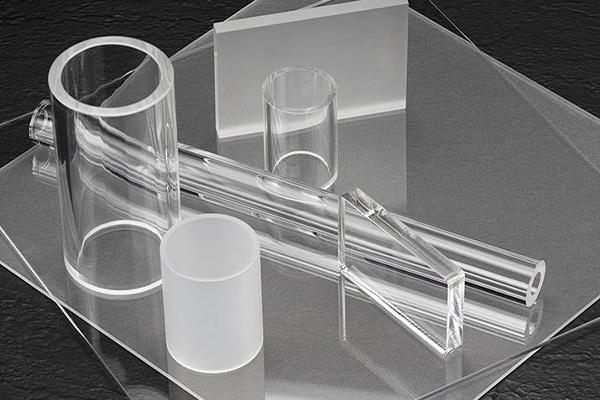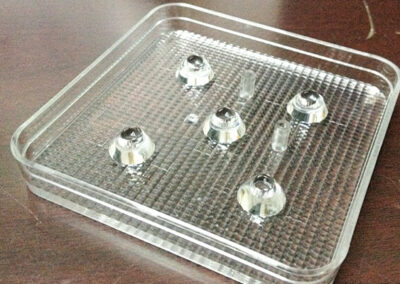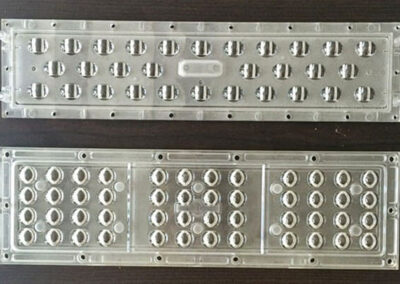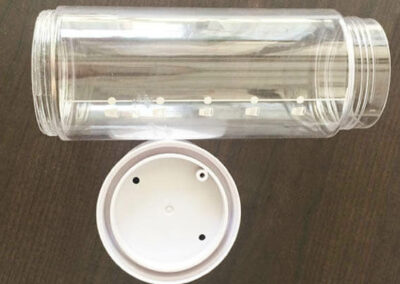Acrylic Molding: Solutions For Acrylic Molded Parts

What is Acrylic?
Acrylic, also known as polymethyl methacrylate (PMMA), is a synthetic thermoplastic material. As a transparent and durable plastic, derived from acrylic acid or its derivatives, and commonly produced through polymerization processes, acrylic is widely used in various industries and applications, including signage, display cases, lenses, automotive parts, household items, architectural panels, medical devices, and more.
Acrylic is known for its exceptional optical clarity, making it an excellent substitute for glass in many applications. It also exhibits good weathering properties, making it suitable for outdoor use without significant degradation over time. Acrylic is lightweight, which makes it easier to handle and transport compared to glass. Additionally, it is relatively easy to work with and can be molded into various shapes and forms.
Acrylic Molding
Acrylic molding has been around since the mid-20th century, when acrylic plastics were first developed. Over 100-year history, acrylic molding has a major position in industrial material and production field. Acrylic molding is the process of shaping and forming acrylic plastic into various shapes, sizes, and objects. The process has since evolved and become more advanced, with new technologies and techniques being developed.
Types of Acrylic Molding
There are common acrylic molding methods including acrylic injection molding, blow molding and Thermoforming to solve the custom acrylic molding detail problems.
Acrylic Injection Molding
Acrylic Injection molding is one of the most commonly used methods for producing acrylic products with complex shapes and precise dimensions. The process starts with the raw acrylic resin pellets being fed into a heated barrel of an injection molding machine. The pellets are then melted under high pressure and injected into a mold cavity.
The mold is typically made of two halves, and the melted acrylic fills the space between these halves. Once the acrylic cools and solidifies inside the mold, the mold is opened, and the finished product is ejected. Injection molding allows for high production volumes and can produce products with consistent quality.
Acrylic Injection molding is suitable for producing a wide range of acrylic products, including automotive parts, electronic enclosures, cosmetic packaging, and various household items.

Blow Molding
Blow molding is commonly used to create hollow acrylic products, such as bottles, containers, and other containers with complex shapes. The process starts with the acrylic resin being melted and formed into a parison (a hollow tube with a hole at one end) using an extrusion process.
The parison is then clamped into a mold, and air is blown into it, causing the plastic to expand and take the shape of the mold. Once the acrylic cools and solidifies, the mold is opened, and the finished product is removed.
Blow molding is suitable for large-scale production of hollow acrylic items with consistent wall thickness and strength. The process is cost-effective and efficient for creating products in various sizes and shapes.
Thermoforming
Thermoforming is a versatile acrylic molding process used to create both simple and complex shapes from acrylic sheets. The process begins by heating an acrylic sheet until it becomes pliable. The heated sheet is then placed over or into a mold and pressed down or vacuum-formed to take on the shape of the mold.
After cooling, the acrylic sheet retains the shape of the mold. This method allows for the production of products with varying thicknesses, textures, and finishes.
Thermoforming is commonly used for manufacturing items like display cases, signage, trays, and various types of packaging. It offers design flexibility, fast production cycles, and cost-effectiveness, making it a popular choice for both small-scale and large-scale productions.
Each type of acrylic molding has its advantages and is suited for different types of products and production volumes. Manufacturers often choose the most appropriate method based on factors such as the complexity of the product, required quantities, and budget constraints.
Advantages of Acrylic Molding
- 1. Transparency and Optical Clarity: Acrylics are known for their exceptional transparency, allowing them to transmit up to 92% of visible light. This property makes acrylic molding ideal for applications where optical clarity is crucial, such as display cases, lenses, windows, and signage.
- 2. Light weight: Acrylics are lightweight compared to glass, making them easier to handle and transport. This property is especially beneficial for large-scale products or acrylic molding applications where weight is a concern, such as in the automotive and aerospace industries.
- 3. Easy to Mold: Acrylics have excellent moldability, allowing manufacturers to create intricate shapes and designs. The material flows smoothly during the molding process, which makes it suitable for producing a wide range of products with varying complexities.
- 4. UV Resistance: Acrylics exhibit good resistance to UV radiation, making them suitable for outdoor applications. They are less likely to degrade or yellow when exposed to sunlight over extended periods, making them ideal for outdoor signage, architectural panels, and protective covers.
- 5. Weather Resistance: Acrylics have good weathering properties, making them durable and able to withstand a wide range of environmental conditions. This weather resistance helps maintain the material’s appearance and functionality over time.
- 6. Excellent Clarity and Gloss: Acrylics have a glass-like surface finish that retains its clarity and gloss over extended periods. This property is particularly advantageous for applications where aesthetics play a significant role.
- 7. Low Water Absorption: Acrylics have low water absorption, which means they are less likely to swell or degrade in humid environments. This property is essential for applications where moisture resistance is necessary.
- 8. Customizable Colors: Acrylics can be easily pigmented, allowing manufacturers to produce products in a wide range of colors. This flexibility in coloring enhances the design possibilities for various applications.
- 9. Good Chemical Resistance: Acrylics exhibit good resistance to many chemicals, making them suitable for applications where exposure to mild chemicals or cleaning agents is expected.
- 10. Versatile Applications: Acrylic molding is used in various industries, including automotive, medical, electronics, retail, and architecture. It can be used to manufacture products such as automotive lenses, medical devices, display stands, light fixtures, and point-of-sale displays.
- 11. Lower Cost than Glass: Acrylics are often chosen as a cost-effective alternative to glass due to their lower production costs and reduced risk of breakage during transportation and installation.
Disadvantages of Acrylic Molding
- 1. Brittleness: Although acrylic is relatively strong, it can be brittle and is prone to cracking or shattering under high stress or impact. This can be a limiting factor for certain applications.
- 2. Scratch Susceptibility: Acrylic surfaces are susceptible to scratches, which can impair the appearance and functionality of the finished product. Special coatings or treatments may be required to improve its scratch-resistance.
- 3. Difficulty in Molding: Acrylic material can be challenging to mold, especially into complex shapes or fine details. It requires precise temperature control, as too high can cause the material to burn or bubble, and too low can result in incomplete molding or filling.
- 4. Cost: Acrylic is generally more expensive than other plastic materials used for molding, such as polyethylene or polypropylene. This can increase the overall cost of the product.
- 5. Sensitivity to Solvents: Acrylic is sensitive to certain solvents and cleaners, which can cause damage or discoloration. This requires careful handling and maintenance.
- 6. Weathering: While acrylic is UV resistant, it can still yellow over time when exposed to prolonged sunlight. Also, exposure to extreme temperatures can cause acrylic to warp or distort.
High-Quality Acrylic Molding
Before the beginning of your business projects, let us master some tips and vital process steps about acrylic molding.
Tips to Make Acrylic Molded Parts
Achieving high-quality acrylic injection molding requires attention to various factors during the molding process. Acrylic can be challenging to mold due to its sensitivity to processing conditions.
Some tips to help you achieve high-quality acrylic injection molding:
- 1. Material Selection: Choose high-quality acrylic resin suitable for injection molding. Ensure that the material has consistent properties and is free from contaminants that can affect the final product’s quality.
- 2. Drying: Acrylic is hygroscopic, meaning it absorbs moisture from the air. Before processing, the resin must be properly dried to prevent defects caused by moisture. Follow the manufacturer’s guidelines for drying time and temperature.
- 3. Molding Machine: Use a modern, high-precision injection molding machine with the necessary controls for temperature, pressure, and speed. This will help achieve consistent and repeatable results.
- 4. Mold Design: Work with an experienced mold designer to create a mold that suits acrylic’s unique characteristics. Proper mold design can minimize stress and reduce the likelihood of defects like warping and sink marks.
- 5. Mold Temperature: Maintain consistent mold temperatures to reduce internal stresses and improve surface finish. Acrylic typically requires lower mold temperatures compared to other materials.
- 6. Injection Speed and Pressure: Adjust the injection speed and pressure to prevent bubbles, flow lines, and other surface imperfections. Too high a speed or pressure can cause shearing, resulting in degraded material properties.
- 7. Cooling Time: Allow sufficient cooling time to avoid premature ejection of the part. This helps prevent distortion and warping during the demolding process.
- 8. Avoiding Jetting: Jetting occurs when the melt does not fuse correctly, leaving visible lines on the surface. Adjust the melt and mold temperatures, as well as the injection speed, to minimize jetting.
- 9. Gate Design: Choose an appropriate gate design to ensure uniform material flow and reduce the risk of defects like weld lines. The gate size and location can impact the final part’s aesthetics and mechanical properties.
- 10. Maintenance: Regularly maintain and clean the molding machine and molds to prevent contamination and ensure consistent production.
- 11. Quality Control: Implement a robust quality control process that includes inspection and testing of both the raw material and the final molded parts. This will help identify and address any issues that arise during the molding process.
- 12. Process Optimization: Continuously monitor and optimize the injection molding process to improve efficiency and product quality over time.
Acrylic Injection Molding Processes
Typical steps involved in acrylic injection molding:
- 1. Material Preparation:
Acrylic resin, in the form of pellets or granules, is selected based on the specific requirements of the final product.
Before processing, the resin must be dried to remove any moisture, as acrylic is sensitive to moisture and can result in defects during molding. - 2. Melting and Injection:
The dried acrylic resin is loaded into the hopper of the injection molding machine.
The material is then fed into a heated barrel where it undergoes melting and homogenization.
The molten acrylic is then injected into the mold cavity using a high-pressure screw or plunger, filling the cavity and taking the shape of the mold. - 3. Packing and Cooling:
After the mold cavity is filled, a packing or holding pressure is applied to ensure that the mold is completely filled and any voids or air pockets are eliminated.
The mold is then cooled to solidify the molten acrylic, taking the shape of the mold. - 4. Mold Opening and Ejection:
Once the cooling time is complete, the mold is opened using ejector pins or other mechanisms to release the solidified part from the mold.
The part is ejected from the mold cavity and removed from the mold. - 5. Trimming and Finishing:
The ejected parts may have excess material or flash, which needs to be removed through trimming or other post-processing methods.
Additional finishing processes, such as polishing, sanding, or painting, may be required to achieve the desired surface quality and appearance. - 6. Quality Control:
The molded parts undergo inspection and quality control measures to ensure they meet the specified requirements and are free from defects. - 7. Recycling (Optional):
Acrylic material waste generated during the injection molding process can be recycled and reused to minimize material wastage.
Applications of Acrylic Molded Parts
- Automotive industry: Acrylic molded plastics are used in automotive applications such as taillights, headlights, and instrument clusters.
- Medical industry: Acrylic plastics are used in medical applications such as surgical devices, diagnostic equipment, and medical implants.
- Consumer goods industry: Acrylic plastics are used in consumer goods such as electronics, home appliances, and furniture.
- Signage and display industry: Acrylic plastics are used in signage and display applications such as point-of-purchase displays, retail fixtures, and trade show exhibits.
- Architectural applications: shop windows, soundproof doors and windows, lighting covers, telephone booths, etc.
- Advertising applications: light boxes, signboards, signs, display racks, etc.
- Transportation applications: doors and windows of trains, automobiles, etc.
- Civilian products: sanitary facilities, handicrafts, cosmetics, brackets, aquariums, etc.
- Lighting applications: fluorescent lamps, chandeliers, street lamp shades, etc.
Challenges and Considerations in Acrylic Molding
- Material selection: Choosing the right type of acrylic plastic is important for achieving the desired properties and characteristics.
- Design considerations: The design of the mold and the part being molded must be carefully considered to ensure that the end product meets the required specifications.
- Molding process considerations: The molding process must be carefully controlled to ensure that the part is produced accurately and with consistent quality.
Future Outlook for Acrylic Molding
Advancements in technology: New technologies and techniques are being developed to improve the efficiency and quality of acrylic molding.
Emerging trends: There is growing interest in using sustainable and bio-based materials in acrylic molding, as well as in incorporating electronics and other advanced features into molded parts.
Sungplastic: Custom Acrylic Molding Parts Supplier
- 1. Experience and Expertise: With extensive experience in acrylic molding and a proven track record in producing high-quality custom acrylic parts, Sungplastic ensures that align with your project requirements and business values.
- 2. Capabilities: Sungplastic has the necessary equipment, machinery, and technical capabilities to handle your specific project requirements. This includes the ability to design, mold, and finish acrylic parts to meet the requirement of your specifications.
- 3. Quality Assurance: Sungplastic has a robust quality assurance process in place to ensure that the molded parts meet strict quality standards. This includes inspection, testing, and compliance with industry regulations.
- 4. Cost-Effectiveness and Material Selection: With the cost control of source and processes, Sungplastic makes a commitment to use high-quality acrylic materials from reputable sources and offers competitive pricing without compromising on quality.
- 5. Customization: Sungplastic offers a high level of custom acrylic molding services to meet your unique needs and adapt to your design and engineering requirements effectively.
- 6. Design and Engineering Support: As a dependable supplier, Sungplastic has a team of skilled engineers who can assist in mold design, feasibility analysis, and provide technical expertise throughout the project.
- 7. Lead Times and Delivery: With strong technical equipment, professional team and abundant producing experiences of many years, Sungplastic can meet your deadlines and deliver the products on time, especially you need a mass production.
For more information, please click on the quotation,or move to other pages: case and blog.
We Will Say Everything We Know. Just For You!
FAQs for Acrylic Molding
- 1. What are other different ways of acrylic molding?
Others common types of acrylic molding are vacuum forming and CNC machining. Vacuum forming involves heating the acrylic material and then vacuuming it onto a mold. CNC machining involves cutting the acrylic material using a computer-controlled machine. - 2. What are the design considerations for acrylic molding?
When designing for acrylic molding, it’s important to consider factors such as wall thickness, draft angle, undercuts, and radii. It’s also important to consider the material’s optical properties and how they will affect the final product. - 3. What kind of equipment is needed for acrylic molding?
The equipment needed for acrylic molding depends on the technique being used. For vacuum forming, a vacuum former is required, along with a heating element to soften the acrylic sheet. For injection molding, an injection molding machine is needed, along with molds and pellets of acrylic resin. For CNC machining, a computer-controlled milling machine is required.
About Sungplastic
Sungplastic is a plastic product manufacturer with rich experience in injection molding. According to the different product development requirements, we flexibly adjust the manufacturing process to achieve high quality, high efficiency and more economical.
We offer a variety of manufacturing services: Rapid Prototyping, Tool Making, Injection Molding, Product Design and Development, CNC Machining and Metal Stamping. You can choose from a variety of plastics, silicone rubber, or metal for your product. Regardless of mass production or small batch customization, Sungplastic has always been committed to providing assured, efficient and more economical one-stop processing services for your projects.
Contact us for a free quote and project review.
Get a free quote and design analysis today.
We’ll reply you within 6 working hours.
We respect your privacy.



